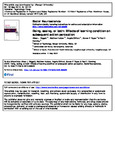Doing, seeing, or both: Effects of learning condition on subsequent action perception
| dc.contributor.author | Wiggett, AJ | |
| dc.contributor.author | Hudson, Matthew | |
| dc.contributor.author | Clifford, A | |
| dc.contributor.author | Tipper, SP | |
| dc.contributor.author | Downing, PE | |
| dc.date.accessioned | 2021-08-20T17:04:22Z | |
| dc.date.available | 2021-08-20T17:04:22Z | |
| dc.date.issued | 2012-11 | |
| dc.identifier.issn | 1747-0919 | |
| dc.identifier.issn | 1747-0927 | |
| dc.identifier.uri | http://hdl.handle.net/10026.1/17634 | |
| dc.description.abstract |
It has been proposed that common codes for vision and action emerge from associations between an individual's production and simultaneous observation of actions. This typically first-person view of one's own action subsequently transfers to the third-person view when observing another individual. We tested vision-action associations and the transfer from first-person to third-person perspective by comparing novel hand-action sequences that were learned under three conditions: first, by being performed and simultaneously viewed from a first-person perspective; second, by being performed but not seen; and third, by being seen from a first-person view without being executed. We then used functional magnetic resonance imaging (fMRI) to compare the response to these three types of learned action sequences when they were presented from a third-person perspective. Visuomotor areas responded most strongly to sequences that were learned by simultaneously producing and observing the action sequences. We also note an important asymmetry between vision and action: Action sequences learned by performance alone, in the absence of vision, facilitated the emergence of visuomotor responses, whereas action sequences learned by viewing alone had comparably little effect. This dominance of action over vision supports the notion of forward/predictive models of visuomotor systems. | |
| dc.format.extent | 606-621 | |
| dc.format.medium | Print-Electronic | |
| dc.language | en | |
| dc.language.iso | eng | |
| dc.publisher | Informa UK Limited | |
| dc.subject | Mirror systems | |
| dc.subject | Action observation | |
| dc.subject | Learning | |
| dc.title | Doing, seeing, or both: Effects of learning condition on subsequent action perception | |
| dc.type | journal-article | |
| dc.type | Journal Article | |
| dc.type | Research Support, Non-U.S. Gov't | |
| plymouth.author-url | https://www.webofscience.com/api/gateway?GWVersion=2&SrcApp=PARTNER_APP&SrcAuth=LinksAMR&KeyUT=WOS:000308984200005&DestLinkType=FullRecord&DestApp=ALL_WOS&UsrCustomerID=11bb513d99f797142bcfeffcc58ea008 | |
| plymouth.issue | 6 | |
| plymouth.volume | 7 | |
| plymouth.publication-status | Published | |
| plymouth.journal | Social Neuroscience | |
| dc.identifier.doi | 10.1080/17470919.2012.686926 | |
| plymouth.organisational-group | /Plymouth | |
| plymouth.organisational-group | /Plymouth/Faculty of Health | |
| plymouth.organisational-group | /Plymouth/Faculty of Health/School of Psychology | |
| plymouth.organisational-group | /Plymouth/REF 2021 Researchers by UoA | |
| plymouth.organisational-group | /Plymouth/REF 2021 Researchers by UoA/UoA04 Psychology, Psychiatry and Neuroscience | |
| plymouth.organisational-group | /Plymouth/Users by role | |
| plymouth.organisational-group | /Plymouth/Users by role/Academics | |
| dc.publisher.place | England | |
| dc.identifier.eissn | 1747-0927 | |
| dc.rights.embargoperiod | Not known | |
| rioxxterms.versionofrecord | 10.1080/17470919.2012.686926 | |
| rioxxterms.licenseref.uri | http://www.rioxx.net/licenses/all-rights-reserved | |
| rioxxterms.type | Journal Article/Review |


